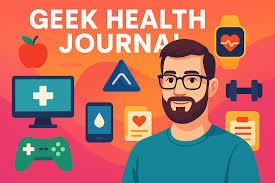
In today’s digital world, health and wellness aren’t just about diet and exercise; they’re about data, smart tools, and intelligent tracking. That’s where the Geek Health Journal comes in. Unlike traditional journals that only log meals or workouts, a geek health journal combines technology, analytics, and habit tracking to help you optimize your physical and mental well-being. Whether you’re a programmer, gamer, student, or tech enthusiast, this method of journaling can transform your lifestyle into something measurable, actionable, and—most importantly—sustainable.
Introduction to the Geek Health Journal
Imagine upgrading your health like you upgrade your PC—tracking every performance metric, fine-tuning your routines, and eliminating bugs (bad habits). That’s the core of a Geek Health Journal.
At its simplest, it’s a personalized system for logging nutrition, workouts, sleep, mood, and other health data. But geeks take it further by integrating wearables, apps, spreadsheets, coding tools, and dashboards. This creates a data-rich environment where you can analyze trends, gamify progress, and even automate insights.
Why it matters:
-
It merges wellness with technology.
-
It turns vague goals into measurable metrics.
-
It keeps motivation high with charts, gamification, and visualization.
Why Keep a Geek Health Journal?
A geek health journal isn’t just for fitness buffs. It’s for anyone who wants to understand their body and brain better, using the same analytical mindset they apply to coding, gaming, or tech hobbies.
Tracking Health Metrics the Smart Way
Instead of guessing how healthy you are, you can track:
-
Steps & Movement: synced from wearables like Fitbit, Apple Watch, or Oura Ring.
-
Calories & Macros: logged through apps like MyFitnessPal.
-
Heart Rate & VO2 Max: collected from fitness trackers.
-
Sleep Quality: measured with smart devices or sleep apps.
Building Long-Term Habits with Data
Data isn’t just numbers—it’s feedback. Seeing your sleep hours compared with your productivity or your step count next to your mood creates connections you’d otherwise miss. This visual loop reinforces healthy habits, much like seeing your progress in a video game motivates you to keep leveling up.
Mental Health & Productivity Boost
Journaling isn’t limited to physical health. You can:
-
Log stress levels, mood swings, and energy.
-
Track focus hours and productivity cycles.
-
Correlate mental states with diet, exercise, or sleep.
Essential Features of a Geek Health Journal
A strong geek health journal blends structure with flexibility.
Digital vs Paper – Choosing the Right Format
-
Digital Journals: Easy to update, integrate with apps, automate reports. Examples: Notion, Excel, Google Sheets.
-
Paper Journals: Ideal for reflection and mindfulness, but harder to analyze.
-
Hybrid Systems: Use digital for data-heavy tracking and paper for mindset journaling.
Must-Have Sections
Every geek’s health journal should cover:
-
Nutrition: calories, macros, hydration.
-
Exercise: strength training, cardio, flexibility.
-
Sleep: hours, quality, bedtime/wake time.
-
Mental Health: mood ratings, stress notes, mindfulness activities.
Here’s a quick sample journal layout:
| Section | What to Track | Tools/Methods |
|---|---|---|
| Nutrition | Calories, macros, hydration | MyFitnessPal, Cronometer |
| Exercise | Sets, reps, time, intensity | Strong app, Strava, spreadsheets |
| Sleep | Hours, sleep score, bedtime routine | Oura Ring, Sleep Cycle app |
| Mental Health | Mood logs, meditation, productivity | Daylio, paper journaling |
Fun Extras for Geeks
-
Gamification: Set XP points for completing daily health tasks.
-
Coding Projects: Build your own fitness tracker using Python or Google Sheets scripts.
-
AI Insights: Use ChatGPT or other AI tools to analyze weekly patterns and suggest optimizations.
Tools and Apps for a Geek Health Journal
Best Wearables and Gadgets
-
Smartwatches: Apple Watch, Garmin, Fitbit.
-
Smart Rings: Oura, Ultrahuman Ring Air.
-
Smart Scales: Withings, Eufy.
Recommended Apps
-
Fitness Tracking: Strava, Strong, JEFIT.
-
Nutrition: MyFitnessPal, Cronometer, Yazio.
-
Sleep & Mindfulness: Sleep Cycle, Calm, Headspace.
Custom Geek Setups
Want to go full geek? You can:
-
Integrate APIs: Pull health data into your own dashboard.
-
Use Notion or Obsidian: Build a modular health tracking system.
-
Create Dashboards: Visualize everything in Google Data Studio or Power BI.
Step-by-Step Guide to Starting Your Own Geek Health Journal
Step 1 – Define Your Goals
Decide if you’re aiming for weight loss, muscle gain, stress reduction, or productivity enhancement. Clear goals make journaling more effective.
Step 2 – Pick Your Tools
Select wearables, apps, or spreadsheets based on your budget and interest level. A smartwatch and a free app can be enough.
Step 3 – Design Your Layout
Choose daily, weekly, and monthly sections. Include metrics, reflections, and visuals.
Example:
-
Daily log → steps, calories, sleep, mood.
-
Weekly review → graphs of activity vs mood.
-
Monthly review → progress summary and goal adjustments.
Step 4 – Track, Review, Improve
The magic lies in iteration. Review your logs weekly and adjust your habits accordingly. If sleep is poor, tweak bedtime. If productivity drops, look at diet or stress data.
Case Studies – Success Stories with Geek Health Journals
The Programmer Who Beat Burnout
A software engineer used an Excel-based health journal to track sleep, coding hours, and exercise. Within 3 months, he reduced burnout by logging stress triggers and adding morning workouts.
The Gamer Who Got Fit
A gamer integrated his Fitbit with a calorie-tracking app. By gamifying workouts (earning XP for calories burned), he lost 20 pounds in 6 months while still enjoying gaming marathons.
The Student Who Boosted Focus
A university student built a Notion health journal. She tracked study hours, caffeine intake, and sleep cycles. Within a semester, her grades improved as she aligned her study sessions with her peak focus times.
Common Mistakes to Avoid in Your Geek Health Journal
-
Overcomplicating the system: Too many tools make tracking a chore.
-
Inconsistent logging: Missing days breaks patterns.
-
Focusing only on numbers: Balance data with real-world lifestyle adjustments.
Future of Geek Health Journals
The next evolution of geek health journals will include:
-
AI-Driven Health Insights: Predicting health issues before they occur.
-
IoT Integration: Smart fridges tracking your diet, beds tracking sleep.
-
Predictive Analytics: Using machine learning to recommend diets or workouts.
Conclusion – Why Every Geek Should Keep a Health Journal
A geek health journal is more than just a diary—it’s your personal health dashboard. By merging wellness with technology, you can take control of your body and mind with precision. Start small, choose the right tools, and let data guide you. Remember, your health is the ultimate upgrade—and a geek health journal is the blueprint to unlocking it.
FAQ – Geek Health Journal
What is the best app for ageek’s health journal?
Apps like Notion, MyFitnessPal, and Strava work well depending on your focus.
Can I use spreadsheets instead of apps?
Absolutely. Google Sheets or Excel are perfect for custom setups.
How often should I update my journal?
Daily for basic logs, weekly for reviews, monthly for big-picture trends.
Do I need expensive gadgets to start?
No. A simple notebook or free app can kickstart your health journaling journey.


